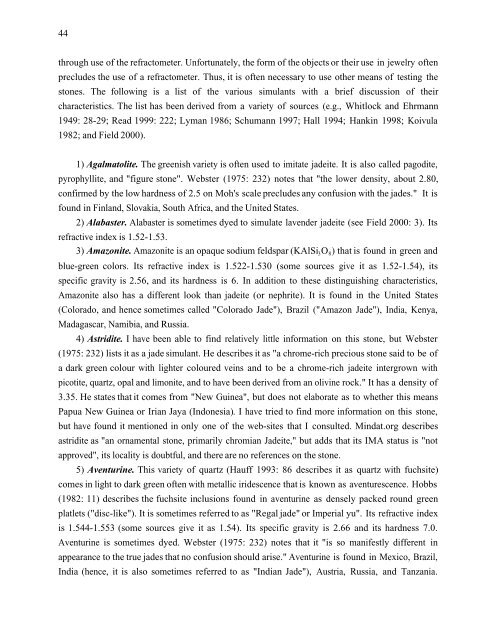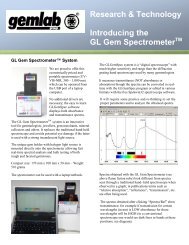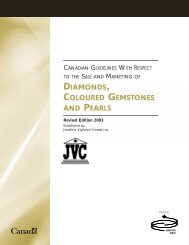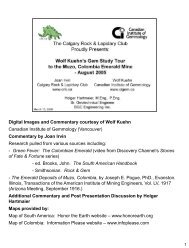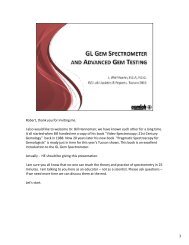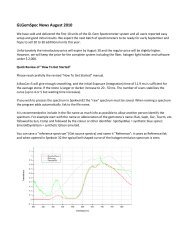JADEITE - Canadian Institute of Gemmology
JADEITE - Canadian Institute of Gemmology
JADEITE - Canadian Institute of Gemmology
Create successful ePaper yourself
Turn your PDF publications into a flip-book with our unique Google optimized e-Paper software.
44<br />
through use <strong>of</strong> the refractometer. Unfortunately, the form <strong>of</strong> the objects or their use in jewelry <strong>of</strong>ten<br />
precludes the use <strong>of</strong> a refractometer. Thus, it is <strong>of</strong>ten necessary to use other means <strong>of</strong> testing the<br />
stones. The following is a list <strong>of</strong> the various simulants with a brief discussion <strong>of</strong> their<br />
characteristics. The list has been derived from a variety <strong>of</strong> sources (e.g., Whitlock and Ehrmann<br />
1949: 28-29; Read 1999: 222; Lyman 1986; Schumann 1997; Hall 1994; Hankin 1998; Koivula<br />
1982; and Field 2000).<br />
1) Agalmatolite. The greenish variety is <strong>of</strong>ten used to imitate jadeite. It is also called pagodite,<br />
pyrophyllite, and "figure stone". Webster (1975: 232) notes that "the lower density, about 2.80,<br />
confirmed by the low hardness <strong>of</strong> 2.5 on Moh's scale precludes any confusion with the jades." It is<br />
found in Finland, Slovakia, South Africa, and the United States.<br />
2) Alabaster. Alabaster is sometimes dyed to simulate lavender jadeite (see Field 2000: 3). Its<br />
refractive index is 1.52-1.53.<br />
3) Amazonite. Amazonite is an opaque sodium feldspar (KAlSi 3O 8) that is found in green and<br />
blue-green colors. Its refractive index is 1.522-1.530 (some sources give it as 1.52-1.54), its<br />
specific gravity is 2.56, and its hardness is 6. In addition to these distinguishing characteristics,<br />
Amazonite also has a different look than jadeite (or nephrite). It is found in the United States<br />
(Colorado, and hence sometimes called "Colorado Jade"), Brazil ("Amazon Jade"), India, Kenya,<br />
Madagascar, Namibia, and Russia.<br />
4) Astridite. I have been able to find relatively little information on this stone, but Webster<br />
(1975: 232) lists it as a jade simulant. He describes it as "a chrome-rich precious stone said to be <strong>of</strong><br />
a dark green colour with lighter coloured veins and to be a chrome-rich jadeite intergrown with<br />
picotite, quartz, opal and limonite, and to have been derived from an olivine rock." It has a density <strong>of</strong><br />
3.35. He states that it comes from "New Guinea", but does not elaborate as to whether this means<br />
Papua New Guinea or Irian Jaya (Indonesia). I have tried to find more information on this stone,<br />
but have found it mentioned in only one <strong>of</strong> the web-sites that I consulted. Mindat.org describes<br />
astridite as "an ornamental stone, primarily chromian Jadeite," but adds that its IMA status is "not<br />
approved", its locality is doubtful, and there are no references on the stone.<br />
5) Aventurine. This variety <strong>of</strong> quartz (Hauff 1993: 86 describes it as quartz with fuchsite)<br />
comes in light to dark green <strong>of</strong>ten with metallic iridescence that is known as aventurescence. Hobbs<br />
(1982: 11) describes the fuchsite inclusions found in aventurine as densely packed round green<br />
platlets ("disc-like"). It is sometimes referred to as "Regal jade" or Imperial yu". Its refractive index<br />
is 1.544-1.553 (some sources give it as 1.54). Its specific gravity is 2.66 and its hardness 7.0.<br />
Aventurine is sometimes dyed. Webster (1975: 232) notes that it "is so manifestly different in<br />
appearance to the true jades that no confusion should arise." Aventurine is found in Mexico, Brazil,<br />
India (hence, it is also sometimes referred to as "Indian Jade"), Austria, Russia, and Tanzania.


